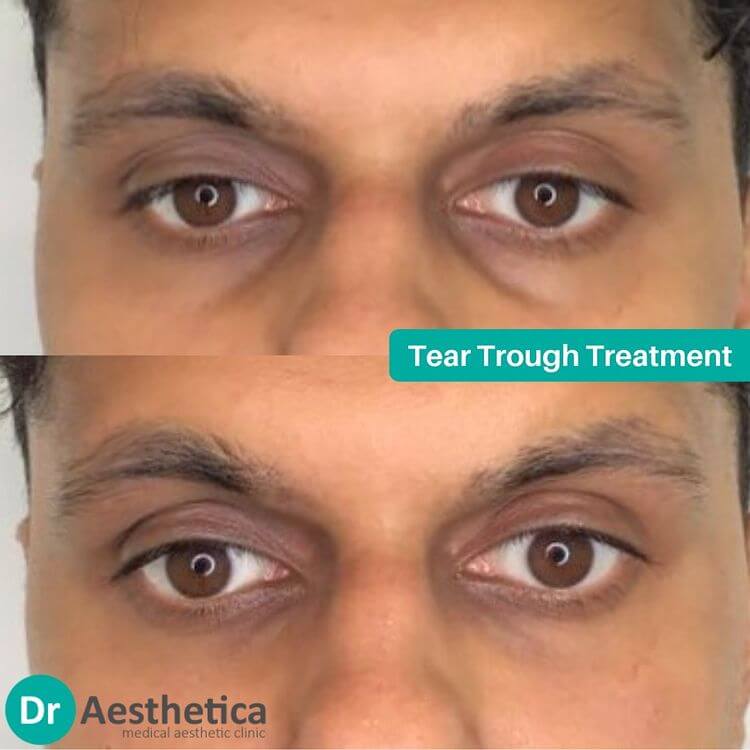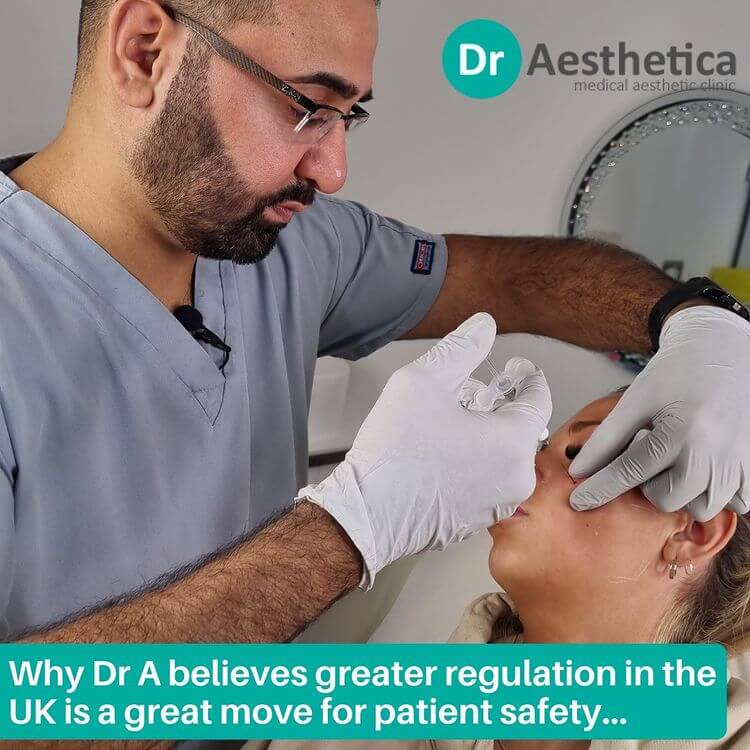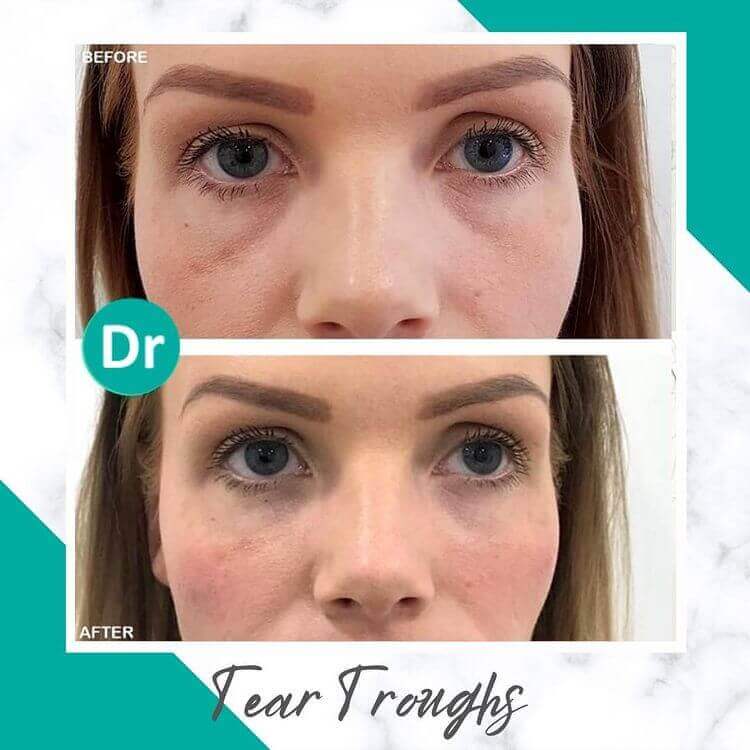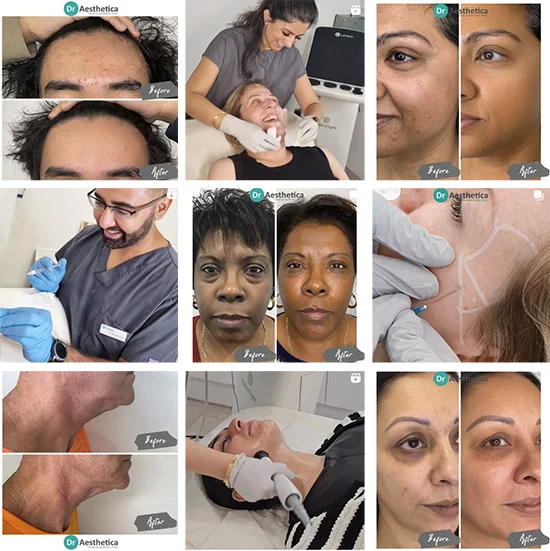If I were to name one major nemesis of a youthful, fresh look, it would be the tear trough.
This depression, which forms under the lower eyelid, is characterized by a sunken appearance under the eye that casts a dark shadow and gives the patient a tired aged appearance
With age, the fat around the eyes can shift forward into the lower eyelid region as the retaining ligaments in this area loosen.
This leads to the "bags under the eyes" effect which can be further exacerbated by the loss of volume in the cheek region.
There is also a loss of fullness due to fat changes that occur in and around the eyes resulting in tear troughs. As you may already know, dermal fillers are the best way to treat these particular ageing issues.
The puffiness under the eyes is not so much the problem, but rather the groove underneath.
Fillers can be used to smooth out the transition so you do not see a break in the felt pads between the under-eye and the cheek itself. They essentially fill the depressions.
We have already written extensively about the benefits of this non-surgical treatment, so that won't be our focus on that today (if you want to know how tear trough fillers work and what their benefits are, click here).
The topic of today's discussion is Under Eye Filler Gone Wrong and the main reasons why this might happen.

What Happens If a Under Eye Filler goes Wrong
You may experience the so-called Tyndall effect, which describes the way light is scattered under certain conditions.
In the case of fillers for the tear trough, injecting the filler too close to the skin's surface can cause the area under the eyes to have a slightly bluish hue.
It is possible that the eyes could look even more sunken than before.
It can result in the development of nodules (growths of skin tissue) that may after the injection.
Can lead to an unnatural appearance and even more puffiness.
This is because the area under the eyes is perhaps the most technically challenging part of the entire face to fill because it is important to maintain a natural facial contour.
One of the procedure's more serious (and rare!) complications is that some of the filler is injected into a blood vessel.
The areas under the eyes and on the forehead in particular are filled with many blood vessels, making them more susceptible to complications from improper filler application.
This can cause the blood vessel to become blocked, (vascular occlusions) which can even lead to can lead to "necrosis (tissue death), scarring and even worse, blindness.

Unqualified Injectors
In the UK, the number of individuals performing filler injectables has exploded in recent years. While injectors with vast experience can successfully improve the appearance of the under-eye area, unfortunately, there is still a large number offering substandard treatments.
Tear trough filler requires thorough expertise in the eye area, which many practitioners lack. Often these individuals have limited medical backgrounds depending on their training in facial esthetics.
I have no doubt that many of these people only want the best when performing facial filler injections. But they do not have the expertise to really help their patients.
But expert under eye filler requires a broad knowledge base as well as the ability to use a variety of facial rejuvenation instruments and techniques.
People without knowledge of facial anatomy can get inconsistent results leading to all these cases we see on the internet of under-eye filler gone wrong.
Lack of Regulations and Best Practice Guidelines
While the products and devices used in nonsurgical cosmetic treatments undergo rigorous product testing, the same is not true for the people who use them.
Did you know that doctors who perform non-surgical cosmetic procedures, including tear-trough fillers, are not required by law to be qualified? Surprising but true.
In the UK, procedures such as dermal filler, botulinum toxin injections, chemical peels, and laser hair removal can be performed by anyone, regardless of their level of training.
Due to the lack of regulations, it is difficult to distinguish between good and bad filler specialists.
What are your legal rights if something goes wrong? Are there best practice guidelines that practitioners must follow?
Is there a regulatory body in place to ensure that safe, high-quality procedures are being carried out across the UK?
These are questions patients need to ask and need answers to. That's also why we registered with the Care Quality Commission (CQC), an independent regulator of health and social care in England.

Being a CQC-approved medical aesthetics clinic means
- Our clinic meets strict quality standards and is safe for patients.
- Our team is competent and knowledgeable in a field where regulation is sadly lacking in many areas.
- Our patients are protected and safeguarded.
The fact that non-surgical cosmetic procedures carry fewer risks compared to their surgical counterparts does not mean they are risk-free.
Any cosmetic treatment, surgical or non-surgical, always carries the possibility of complications. Although there are a number of recommended professional standards for cosmetic treatments set by, for example, the Royal College of Surgeons and voluntary accredited registries such as the Care Quality Commision, those who adhere to these recommendations do so largely on a voluntary basis.
Therefore, providers of these treatments must act in good faith and submit to a degree of scrutiny by regulatory bodies.
Otherwise, the end result is lots of disappointment after a tear trough filler procedure. And worse, no one is held accountable.
At Dr. Aesthetica, we excel in providing safe and effective tear trough procedures. Our team is not only experienced but also fully insured and CQC registered, upholding the highest safety and care standards. Our commitment to excellence is echoed in our over 150 five-star reviews on Trustpilot and Google.
Ready for a transformation with a trusted expert? Learn More and Book Your Consultation Today.
Use of The Wrong Filler
There are several classes of dermal fillers. In particular, tear trough filler injections are carried out with hyaluronic acids (Juvederm®, Restylane®, Belotero®).
The good news is these can be dissolved by injecting a product called hyaluronidase. This enzyme can be used to dissolve all hyaluronic acid filler injected into the face.
This dissolution may be necessary if the filler is affecting the blood supply to a part of the face. It may also be useful to correct problems when these fillers produce poor results.
Over the past year, I have been dissolving more and more poorly placed fillers for patients who come to me after disappointing treatments elsewhere.
I am just happy to have a product that works and makes it possible for me to help these patients.
Unfortunately, the other classes of fillers (Radiesse®, Sculptra®, Artefill®) do not have an agent that dissolves them.
Therefore mistakes made with these fillers are very difficult to reverse.
Often, the patient might have to opt to use invasive surgical techniques to remove these products.
Therefore, I strongly recommend against using these types of permanent and partially permanent filler products in the eyelid region.

Negligence on the Part of the Patient
NEVER buy injectables on the internet or try to inject them yourself. You would be surprised how many people try to inject fillers themselves.
DIY fillers more times than not result in the case of fillers gone wrong.
Also, keep in mind that your facial or eyelid anatomy may not be suitable for an under-eye filler.
Yes, this is possible and a reputable injection specialist will be able to tell you.
If this is the case, trust your doctor and do not try to go to a non-certified med spa just because you want to have this treatment done.
As always, you are perfect the way you are. Even if you need something touched up, it should never be at the expense of your health.
On a separate note...
Ready to learn more about enhancing your under-eye area? Let’s explore further with our comprehensive guide on Tear Trough Filler treatment in Birmingham!


